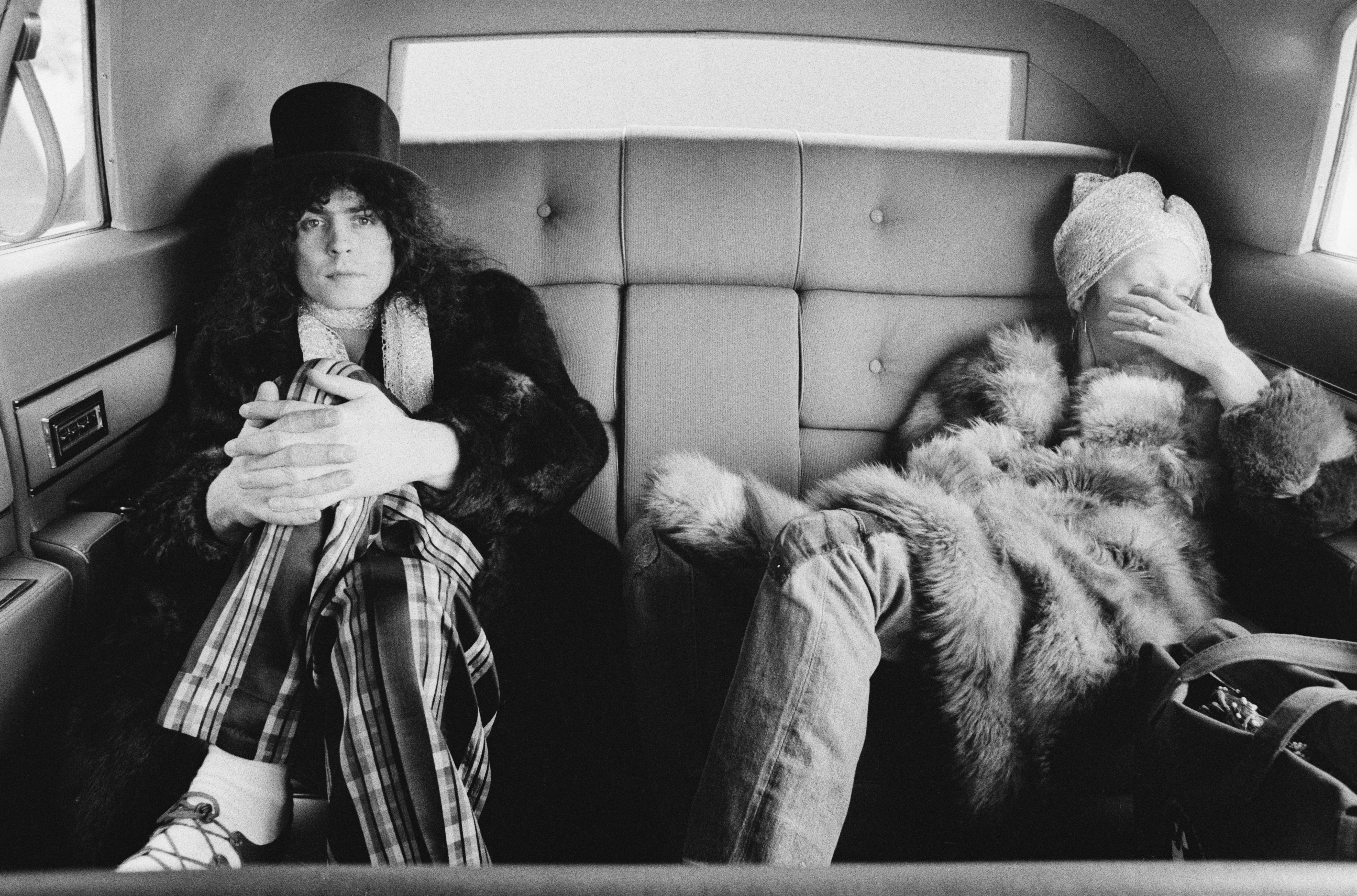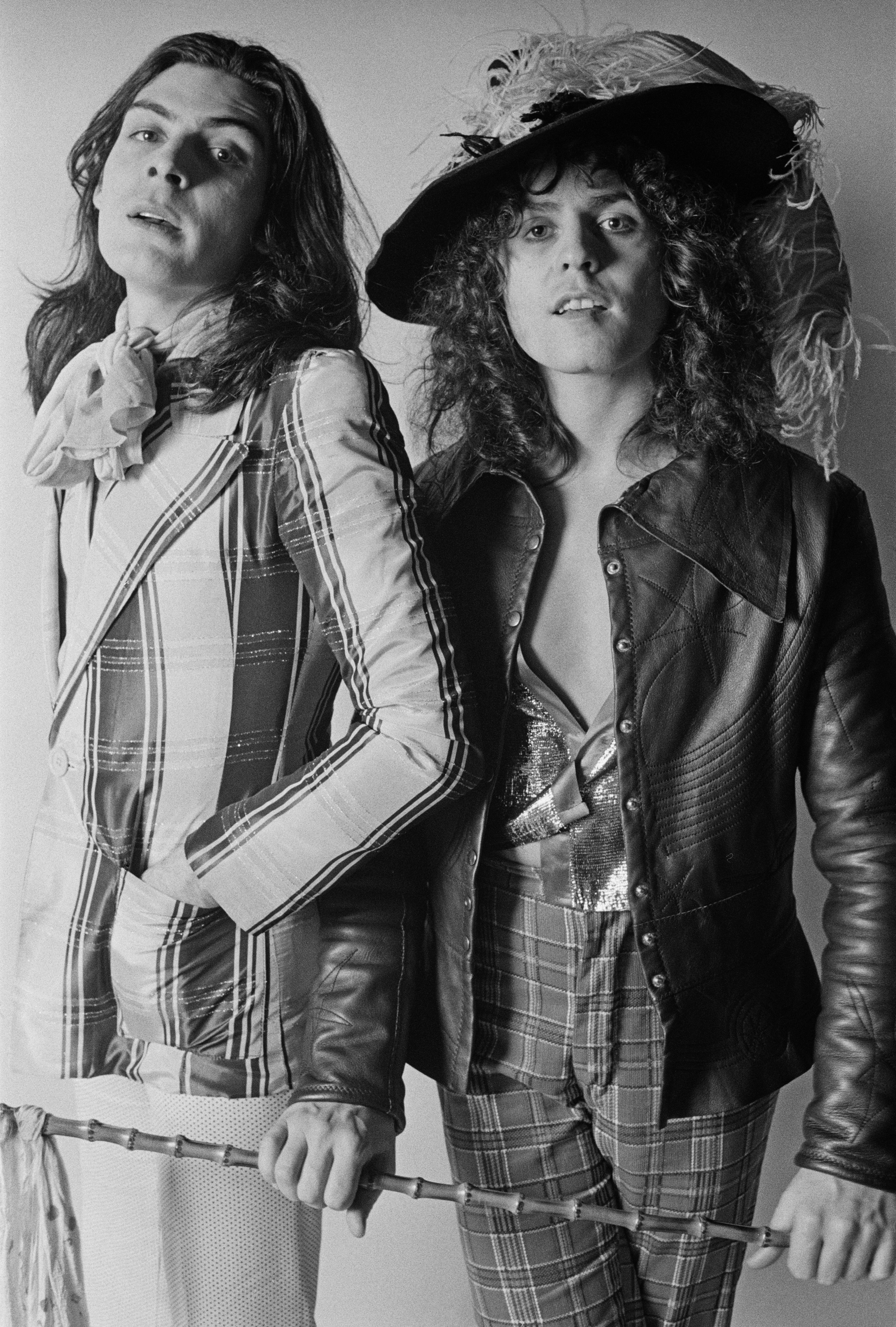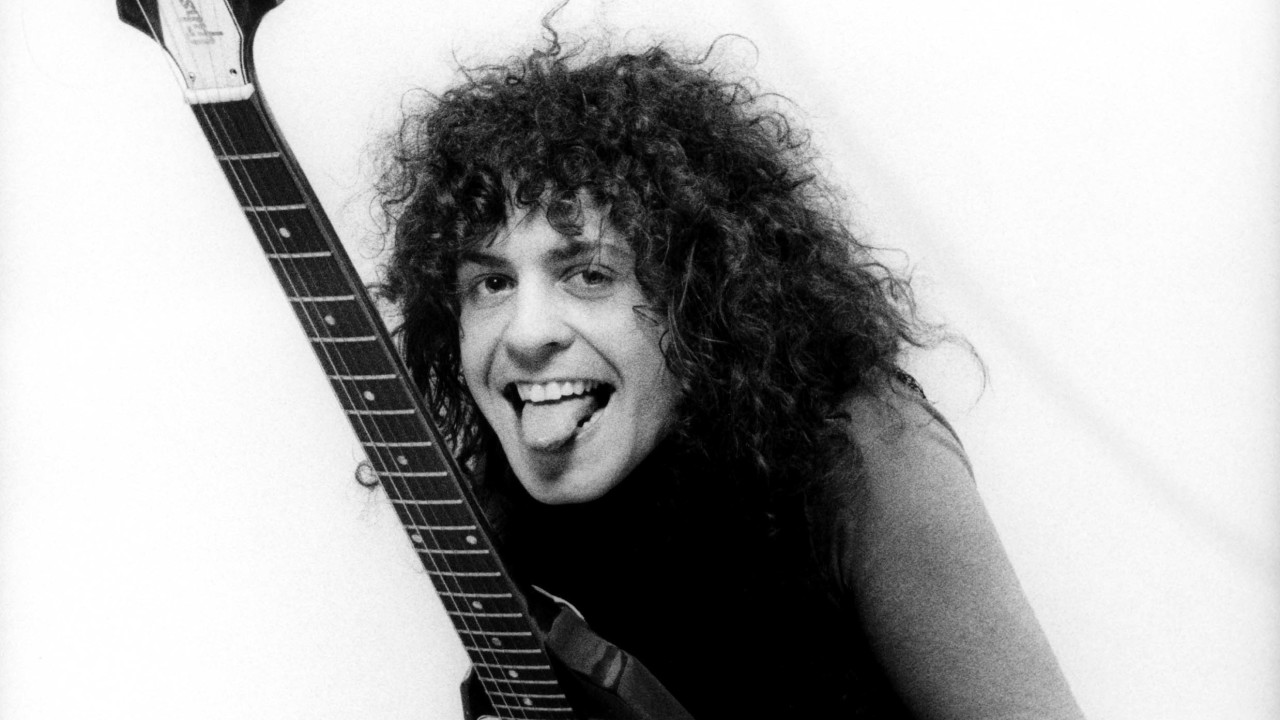In October 1971, the rock cognoscenti were doubting whether one of the realest records you’ll ever hear was real. But Marc Bolan, the man who’d made it, knew better. “Oh, come on,” he told Record Mirror. “I’ve always been a wriggler. I dig dancing. It was just a bit difficult to wriggle when I was sitting cross-legged on the stage. I mean, I am my own fantasy. I am the ‘cosmic dancer’ who dances his way out of the womb and into the tomb. I’m not frightened to get up there and groove about in front of six million people on TV just because it doesn’t look cool. That’s the way I’d groove at home.”
The boy could talk. In Melody Maker he was saying: “Neither Dylan or Lennon are better than me, and they know it. They know where I’m at – I’m different, like them. I’ve known I was different from the moment I was born.”
The record in question, Electric Warrior, had been released a fortnight earlier. It would be the UK No.1 album well over Christmas and into February 72, staying in the chart for almost a year. It nudged the US Billboard Top 30 and even gave Bolan a US Top 10 hit with Get It On; actually, Bang A Gong (Get It On), to avoid confusion with the forgotten jazz-dance Chase hit Get It On, and not because, as is often stated, the Americans were prudish. In Britain, Get It On and Jeepster were all-conquering follow-ups to Hot Love. (Well, maybe not “all-conquering”; Jeepster was denied the top spot by Benny Hill’s Ernie.) T.Rex were huge: so huge, so quick, that the term ‘T.Rextacy’ – a new Beatlemania for a new decade – was coined by their publicist, BP Fallon.

Yet for all the feverish furore, Electric Warrior wasn’t a flash in the pan. More than 40 years on, its brash trashiness still wriggles and grooves, but it has endured as one of the all-time great rock moments. An album recorded in haste, on the hoof, while Bolan’s star was going supernova and his life going crazy, it stands as tall as the figure on its iconic Hipgnosis-designed sleeve.
Bolan added at the time: “It’s my life, and I’m enjoying myself more now than ever before. I’m a rock’n’roll poet man who’s just bopping around on the side. My head is perfectly clean inside. I’m sorry if my actions upset some people, but I’m absolutely honest about what I’m doing and I know it gives lots of people pleasure. Those who are offended can always switch off. I believe in it, and if they don’t like it they can ride a bike! Electric Warrior might appear simple on the surface, but it has a lot of little ‘sneakies’ in there if you want to dig deeper…”
Its producer, Tony Visconti, says the album documented “an enchanted period”, when he and his collaborator of approaching five years had learned “how to make hits – and were loving every minute of it”.
Hot Love was No.1 as T.Rex took on their first American tour, in the late spring of 1971. After recording in LA, Bolan and the boys visited Visconti in New York – for dinner, his mum made them lasagne, and a chocolate cake with ‘Hot Love’ written on top in sliced almonds.
Marc was eager to record while in Manhattan. Visconti sourced Media Sound, a converted church between Broadway and Seventh Avenue. T.Rex recorded Lean Woman Blues, Girl and Jeepster. The band were buzzing. “The atmosphere that day was electric,” Visconti has written. “With two big hits under our belt and a tour in America, it made all of us feel like heroes.”
“Just go in and mic everything live and we’ll play,” Bolan told Visconti. The intent was to emulate the spontaneous energy of Sam Phillips’s early Sun sessions with the likes of Elvis, Jerry Lee Lewis and Carl Perkins. The producer played up the cavernous studio’s natural reverb: Jeepster was galvanized. Already demoed in London (as were Mambo Sun and Cosmic Dancer), the song had gone through various changes, not least lyrically – the chorus had previously settled as ‘standing in the shadows of your love’. Possibly, Marc had heard the Four Tops. The track also owed a debt to Chuck Berry, Howlin’ Wolf and Elvis. Something about the Broadway boogie around him saw Bolan emphasising cars and girls. He was a whirl of enthusiasm. “I wish Otis Redding was around!” he yelled, never short on bravado. “He could put backing vocals on this!”
“Bolan… was no longer simply recording a song,” Mark Paytress writes in the notes to the new 40th anniversary edition. “He was channelling the last 20 years of popular music.”
Visconti has recalled that Bolan got so excited he split his trousers, PJ Proby-style. “I have a lovely picture of my friend Barbara mending them,” he says. “Marc’s standing behind a piano, but you can see his butt sticking out, and he’s grinning at the camera.”
Bolan’s verve extended to marking out the intro to Jeepster by stamping his Cuban heels on the floor. A faulty pre-amp lent Marc’s happy feet a strange, ricocheting sound, which further boosted the intro’s natural combustion. Through a mix of mysteriously summoned magic, the studio’s ridiculous reverb and the chutzpah of a pumped-up singer who didn’t care if his backside was sticking out of his pants, those foot-stamps were to form one of the most enduringly recognisable intros in pop history. You hear those feet, you know Jeepster’s coming, and you know you’re waking up. And so were the 70s.

Electric Warrior was recorded piecemeal across the States and in London, in rushes and pushes of breakneck boldness and snap decisions. “We spent no more than six weeks in the studio. over a four- month period,” Visconti has said. It may not have been thought through with mature calculation, but it is a testament to the perfect moment when a star’s confidence peaks, before sliding into arrogance.
“I don’t really know what I am or where I’m from,” Bolan told New York journalists in February 72. “I just know that I’m not from here.” He didn’t mean he wasn’t from New York. He meant he wasn’t from Earth. On US radio, he read his poem bearing the album’s name:
‘He came from the past. His frozen eyes had known our planet’s childhood… with one soulful wail, a thousand mean ones were burned. Then he’d turn and jive on into my songs. For his name is Electric Warrior.’
Bolan was no longer the folkie minstrel who’d warbled through Tyrannosaurus Rex’s extraordinarily long-titled songs. He’d gone electric. John Peel wasn’t impressed by his friend’s new direction; thousands of teenagers, though, were. The first album under the name T.Rex had introduced rock guitars and rhythms; Ride A White Swan and then Hot Love had taken to the charts faster than most. The basic duo of Bolan and bongo-playing sidekick MickeyFinn was bolstered, initially for live purposes, by bassist Steve Currie and drummer Bill Legend. (Legend’s surname was Fifield – Bolan, acquiring him from a band called Legend, thought it better.) On the way to a Top Of The Pops appearance, Bolan’s new PA, Chelita Secunda, dabbed glitter under Bolan’s eyes and – according to glamlore – glam rock was born. Marc’s old hippie following tugged their beards and called him a sell-out, and words about wizards and dragons were replaced by actions about sex and lust and cosmic wriggling.
Bolan was regularly tied up with promotional duties, though one hesitates to use the word ‘duties’ – he lapped up attention. He fancied more of the same when the band landed in New York on April 6. He was disappointed to learn that T.Rex, the biggest thing since The Beatles in his homeland, and definitely in his head, were lined up to play shows as third on the bill to Mountain at the Fillmore East. Yet he told the NME: “I’m forcing myself to grow. In the past I wouldn’t have taken such risks. Everything I do now is a risk. I’m very self-destructive.”
Initially, Visconti hadn’t been invited to the American adventure. “It was a risky period,” the producer has said. “He was going to make those recordings without me.” As it turned out, the then London-based Visconti was visiting his Brooklyn home for the first time in four years just as T.Rex “invaded” America, and both parties realised it would be foolish not to let things fall into place. “Once I was out there, Marc and I hooked up again pretty quickly.”
Just prior to the New York bout of cake- charming, trouser-splitting and Jeepster-nailing, Visconti flew to Los Angeles to join up with the band as they played two nights at the Whisky A Go Go. Marc was hanging out with Flo and Eddie (Mark Volman and Howard Kaylan) at Kaylan’s Laurel Canyon haven. The Turtles and Mothers Of Invention singers, larger-than-life characters, had already contributed to the ‘la la la’s of Hot Love. Visconti says vocal lines for Planet Queen and Monolith were sketched out beside Kaylan’s swimming pool. Sessions occurred at Wally Heider Studios. Bill Legend recalls hurriedly learning Get It On in Bolan’s Sunset Strip hotel room by tapping along on a snare drum as the singer ran through the number. “If anything went over three takes,” Visconti has recalled, “he’d throw it out.”
- The 10 best obscure glam rock songs, by Joe Elliott
- “We were out of it, all the time”: Inside David Bowie’s Station To Station
- Marc Bolan & T.Rex - Born To Boogie: The Motion Picture DVD review
- The Last Days Of Marc Bolan
Bolan was high on success which, even at 23, he’d spent years believing would be his. He was in the frame of mind musicians sometimes get into where they believe – they know – that every noise they emit is flushed with irrefutable genius. This commonly leads to disaster, and in later years it became Bolan’s Achilles’ heel. “This album represents the pivotal point between audacity rewarded and hubris punished,” Charles Shaar Murray wrote in 2001. The thing is, throughout the gestation and birth of Electric Warrior, Bolan was irrefutably right. He forgot his detractors and embraced his lusty new following. On April 24 he’d been to a lecture by the Indian mystic Krishnamurti, and felt vindicated by the mettle of the guru’s message: change equals personal growth. How exactly this influenced lines like ‘bleached on the beach/I wanna tickle your peach’ remains indistinct.
Returning to Britain in May, T.Rex toured to scenes of unprecedented fan hysteria. The America trip quickly seemed a long time ago. But when Bolan and Visconti sifted through what they’d recorded there, and stirred it in with earlier UK sessions, they couldn’t help beaming. “We didn’t think we were making an album,” says the producer. “It had been very relaxed in the States. What we’d thought we were doing, probably, was amassing singles.” (Bolan’s decision to put three tracks on singles, and to keep ticket prices low, was radically generous for the time.)
They had something more than a few singles. Between T.Rex dates, each of which offered deafening confirmation that Bolan was now the rock messiah he’d been telling everyone he was, they honed the tapes. Visconti remembers: “Marc and I had a long list of sonic tricks and musical signatures in our arsenal by now. We were using tape flanging and phasing, unrealistic reverbs, backwards guitars, cool pedals… even tape loops.” He references “Marc’s love of black R&B”. Visconti’s strings are, he says, “reminiscent of early 60s pop like Will You Still Love Me Tomorrow?.” Session men were brought into Advision to add final touches. Ian MacDonald, of King Crimson, played sax. Rick Wakeman added piano to Get It On (of which Bolan said: “I honestly believe it’s one of the best things I’ve ever done”).
An album of raw power and effortless elegance seemed ready, but Bolan wanted one last grace note. He recorded a number he’d begun creating in LA. Rip Off – the original master tape boxes have it titled The Rip-Off – was a fusillade of bile and brio which took the texture and lingering tastes of Electric Warrior on to another plane. “When people say that sounds like it belongs somewhere else,” Visconti says, “I say: absolutely right! That was so last-minute, an unconsciously made gem – it was done with another part of the brain.” It cascades into a coda of feedback and sax-addled drone which Mark Paytress describes as “more Stooges’ Fun House than vintage Sun or Shirelles”. And Bolan? “It’s very straight-forward,” he deadpanned. “Just someone laying down a jive.” Anyone who can’t hear its influence on punk is full of jive.
Electric Warrior became Bolan’s coronation. The iconic sleeve (and free poster,) effectively serving as a big, gold sign saying Worship Me For I Am The New Rock God, was soon ubiquitous. He was Hendrix and Dylan and Jagger rolled into one. Ringo Starr’s endorsement held water with the snootier members of the press; pin-ups of Marc were of more interest to readers of Jackie magazine. Morrissey has declared: “Marc was the first pop artist who seemed to be telling us that the future was more important than the past. Nothing dates those songs.”
Nick Logan’s NME review read: “It’s dead easy to knock T.Rex today – it’s everyone’s favourite bloodsport – but Bolan stomps and stamps on. Whether or not you feel that he has butchered the spirit of Tyrannosaurus Rex, you must admire his composure and concede his sincerity.” Ten years ago I began a review of Electric Warrior thus: “The Bible, the Holy Grail, the Golden Fleece, Excalibur, Rosebud: one long, orgasmic, cosmic YEAH.” And finished it: “Future rockologists will place this as the hissing, stomping link between Led Zeppelin and punk; the narcissism predates Prince. An epochal, euphoric event album: a blue-suede Zeus which will mount new listeners roughly and without ceremony.”

The album’s influence on subsequent generations is incalculable (from Adam Ant to punk to goth to Pixies, from The Smiths to Suede). One only wishes it was even greater, that more had assimilated its charisma. “If you enjoyed the music of T.Rex it seemed to prove that you were someone,” Morrissey, who was to cover Cosmic Dancer, wrote in the foreword to Tony Visconti’s book Bowie, Bolan And The Brooklyn Boy. “Here, it seemed, was art in motion.” It rippled away from rock too: surely the least-acknowledged derivation in music history is the torch picked up by Prince, who is as much a child of Bolan – a self-adoring electric elf – as he is of James Brown. “All the signs were there,” observes Simon Price, the Independent On Sunday rock and pop critic, “from the corkscrew hair and glamorous glad-rags to the sexually charged symbolism and the knack for a killer pop hook. There’s no way that an Anglophile and scholar of pop like Prince would have been unaware of Bolan. Get It On was blatantly the template for Prince’s Cream. And not just the melody: compare ‘you’re dirty-sweet and you’re my girl’ and ‘you’re filthy-cute and baby you know it’. In case we didn’t get the point, he did it again on Peach.”
The dance had begun. There was much to come – no career has reached its apex when Metal Guru and Telegram Sam have yet to be scaled – but this was the golden dawn of the glam god. “It’s a highly communicable album,” said Bolan. “There is so little time for us all that I need to be able to say what I want quickly and to as many people as possible.”
Is Electric Warrior the T.Rex masterpiece? “In retrospect it probably is,” says Rick Wakeman. “Although you must never let it overshadow all his other greats.”
Four decades on, it’s still an album on which nothing could be improved: a funky, freaky fairy-tale, a majestic, madcap monolith to man-boy Marc and his mambo sunrise.
This article originally appeared in Classic Rock #171.

